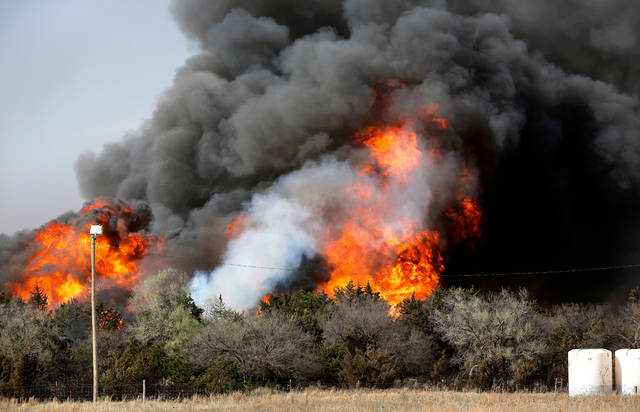OKLAHOMA CITY — Frazzled residents in a part of rural northwestern Oklahoma paralyzed by days of wind-whipped wildfires expressed fear a blaze could overrun their home Wednesday, as firefighters battling the deadly fires there and in Colorado, Kansas and New Mexico found some relief at the promise of easing of dangerous weather conditions.
Hundreds of people across the region have been forced to evacuate their properties, homes have been swallowed by the fires and cattle burned to death as they stood in rivers and streams, presumably seeking respite from the flames. Two people have died and at least 9 injured in the Oklahoma fires.
“We are surviving, tired of the fire, stressing. It’s been very devastating,” said Denise McDaniel, who with her fiancee was forced to leave their home in Canton, Oklahoma, Tuesday night because of a large fire that started near Leedey. That fire has burned about 409 square miles (1,059 sq. kilometers) and is an estimated 3 percent contained.
“I don’t know what words to use to describe what’s going on over here,” said McDaniel. “Our home is still there, but if the fire reaches the town of Canton, our home won’t be there.”
U.S. Forest Service spokesman John Nichols, who has been working with firefighters battling a blaze estimated at about 106 square miles (275 sq. kilometers) that started near Woodward, Oklahoma, said he welcomed reports indicating wet weather could be on the way.
“Some rain might be coming in Thursday night. Thursday morning would be better,” Nichols said. The Woodward fire is about 45 percent contained.
On Tuesday, the National Weather Service warned that much of New Mexico, parts of Texas, Oklahoma and Kansas were at an extreme risk of wildfires, due to a heady mix of hot, dry weather and strong winds, in some places gusting up to 80 mph. Temperatures reached 99 degrees (37 Celsius) Tuesday at Woodward, with humidity as low as 4 percent and wind gusts of up to 51 mph (82 kph).
The service relaxed that fire risk warning to critical for much of the region Wednesday.
Fires in Colorado licked Denver suburbs on Tuesday, stretching firefighting resources to their limits and taking out homes. Other fires jumped the state line into Kansas, where they were contained early Wednesday. Homes have been burned or destroyed in Kansas and Oklahoma too, although emergency management officials have been unable to provide exact numbers because the areas affected by wildfires were still too hot to enter. Kansas Gov. Jeff Colyer and Oklahoma Gov. Mary Fallin have issued disaster declarations.
In northwestern New Mexico, the milder weather conditions Wednesday should be useful for firefighters who were hindered by strong winds a day earlier but managed to keep wildfires largely in check on a mountain and a butte near Grants. Notices warning area residents to be ready to abandon their homes at a moment’s notice have been lifted and an evacuation center in Grants closed.
The fire has killed an undetermined number of cattle in Oklahoma, but Woods County Extension Agent Greg Highfill said the number is at least in the hundreds. Authorities are focusing on the animals that have survived.
“We’re kind of in a desperate need for hay to get us through the next couple of weeks,” because the fire has also destroyed pastures used to feed the herds, Highfill said.
———
Associated Press reporters Heather Hollingsworth in Kansas City, Missouri, and Paul Davenport in Phoenix contributed to this report.



